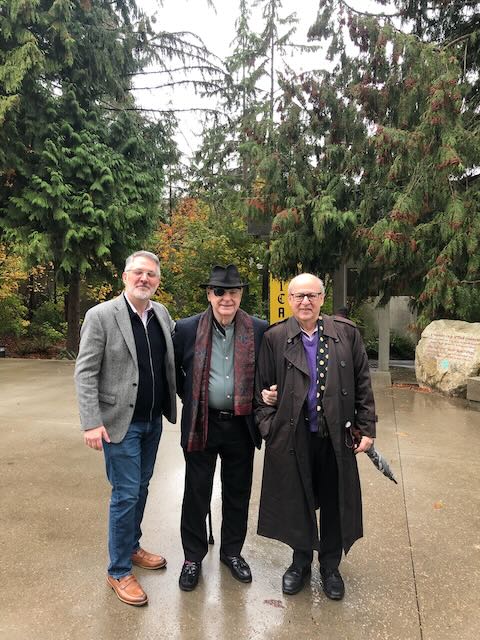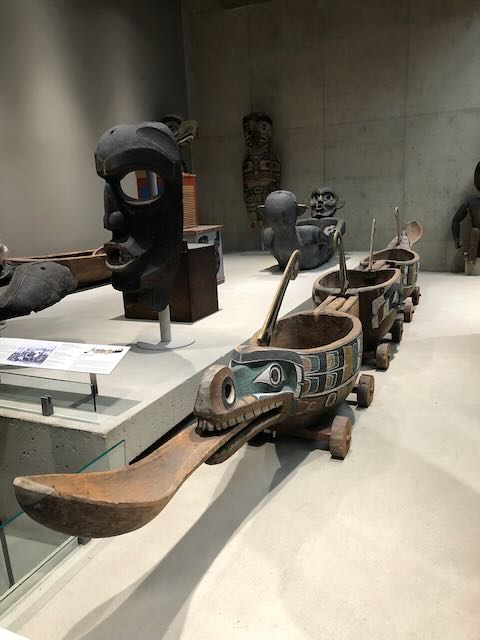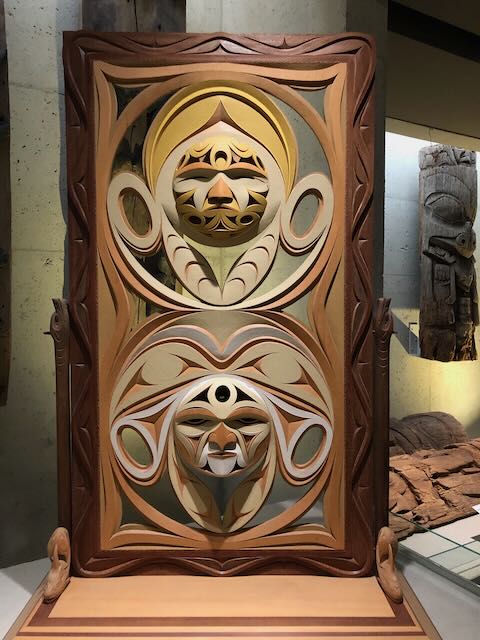Last October, after we had crossed Canada by train (The Canadian, highly recommended), Andrew and I spent the remaining weeks of our vacation in further explorations in Vancouver and, for a bit, in Victoria. Some of these activities (and the train trip) were captured in our several “digital postcards,” posted to the right here.
The vacation was a splendid adventure for us. It was my second visit to Vancouver, and the third for Andrew, as he had visited Vancouver as a young man. In our earlier trip together (in 2014) and in this visit, we were especially taken with our opportunity to learn more about Northwest Coast Art. It’s a type of art generally created by artists from the several First Nations tribes of the Northwest Coast of North America, from pre-European-contact times up to the present. The members of these First Nations tribes are referred to as “First Peoples.”
As in the rest of North America (and elsewhere), when Europeans came to settle the Pacific Northwest, there were already thriving native populations in place. These, then, were the First Nations and the First Peoples.
Their works of art are intriguing, and, for me, many are particularly beautiful. They are developed with a wide variety of forms, techniques, and materials and I find most of what is described as Northwest Coast Art very pleasing. And while the more “formal” discovery and appreciation of this art style have been relatively recent, as an art form of the First Nations/First Peoples it goes back many years. Created by Indigenous peoples who are inheritors and practitioners of unique cultures and ways of relating to people and the environment, there is probably not any way to establish specific dates for Northwest Coast Art but it nevertheless is now recognized for the beauty it brings to today’s society.

Our explorations on this visit were equally satisfying to those of nine years earlier, since we were able to share both with others. In 2014 we had our good friends Dale and Debi Stanley with us, and this time, Kevin Manion, another special friend, joined us from Seattle. Both times, being with our friends, we enjoyed learning more about this stimulating art form as it became more familiar.
During that earlier visit, we had been so impressed with what we found at the Museum of Anthropology (MOA) of the University of British Columbia that I wrote a blog post about the collection, simply because we wanted to share our enthusiasm (the post is at Dateline Vancouver: British Columbia’s Museum of Anthropology).
This time, we were thrilled at MOA with what we saw (despite the fact that the museum’s iconic Great Hall is being re-built in order to upgrade the resiliency of the Museum and to protect its irreplaceable collection in the event of a major earthquake). And we were not at all dissatisfied that Kevin and Andrew and I had a rainy day for MOA; and as for the citizens of Vancouver, they were over-joyed for it was the first rain they had seen since May.
And before we went to the museum with Kevin, we had tried to prep ourselves with a little more background about its collections (especially Northwest Coast Art), hoping that with what we might learn we could “take in” more of what we saw and try to connect the pieces with some of what we had learned about the people.
For one thing, the museum seems a little different from when we visited in 2014 (aside from the rearrangement of the collections because of construction). It is a remarkable place to visit. Earlier, of course, because we were just being introduced to the collection, we didn’t realize the wide range of items, all of them naturally part of what is referred to as Northwest Coast Art.

Of special interest to Kevin, Andrew, and me was much we had not seen before, including, for example, a group of the ancient “wagons” (I suppose we might call them) shown in the photo at the left. These were designed to be used for transporting food prepared elsewhere to the sites of the great festivals held by the First Peoples. From what we were told, they were probably carved from tree trunks and as it was the custom (so some scholars assert) to prepare large quantities of food for the many people who would attend these events. Several wagons would be required, as the design of the wagon did not have much “carrying capacity.” Hence they were linked together in a “train,” so several could be pulled at once.

Another intriguing work is what appears to be a wooden screen of some sort. I could not figure out what its decorative image represents and could find no label or documentation. (But that doesn’t matter, does it?) It is – whatever it is – a beautiful and rewarding work of art. The screen is large, and the carved wooden figures obviously represent human faces (or perhaps or spirits of some type), with two distinct “looks” to intrigue the viewer. The carefully carved surrounding “frame” is a different wood, and the contrast with the woods used in the screen itself and the supporting base make up a charming total picture. As an example of what visitors to the University of British Columbia Museum of Anthropology encounter, this is very special indeed, and I found it particularly beautiful.
[Additional photos of selected MOA items are here.]
Leave a Reply